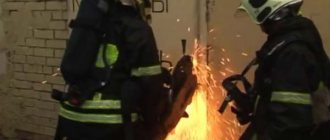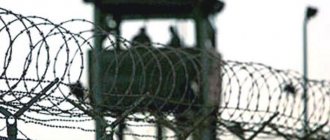Is an administrative offense always a basis for bringing to administrative responsibility? No not always. The Code of Administrative Offenses of the Russian Federation provides for several mechanisms for exemption from such liability, for example, according to Art. 2.7, if a person caused harm to legally protected interests in a state of extreme necessity. But what is “extreme necessity”?
An analysis of judicial practice shows that persons brought to justice often refer to this article, but not everyone manages to achieve a decision in their favor - primarily due to an incorrect interpretation of the meaning of the concept of “extreme necessity.”
So, in some cases the courts agree with the arguments about acting in a state of emergency, but in others they do not. Let's talk about what “extreme necessity” is from the point of view of the Code of Administrative Offenses of the Russian Federation.
Necessary defense
The concept of necessary defense is more closely related to the branch of criminal law. What is meant by necessary defense? Necessary defense is protection from criminal attacks on oneself or other persons . The condition of necessary defense excludes criminal liability. However, the law clearly states that the necessary defense must be proportionate to the attack. And this is where problems with value judgments arise.
To give a simple example, going beyond the necessary defense would be a fatal shot at an attacking person if he is armed only with a stick. But taking into account the special nature of this concept, even in such a situation one can find certain circumstances that will tip the scales in the direction of not exceeding the necessary defense. That is, in defense, the harm must necessarily be caused to the very person who originally tried to carry out the criminal attack.
The law also provides for the fact that even if it is possible to call for help or run away, if the attacker was injured, this will still be assessed as necessary defense. Exceeding the limits of necessary defense constitutes a special, separate crime not associated with any other criminal acts. In general terms, an example can be given as follows: an attack on a person by a criminal with a knife, while the potential victim stuns the criminal with a stick, fearing for his life and health.
The goal of necessary defense is to stop the criminal attack and prevent its recurrence in the future. With this action, the initiative to use force to eliminate a criminal attack comes from the person himself; he acts at his own request.
Necessary defense in cases of administrative offenses: issues of law enforcement
Viktor Gerasimovich Shevtsov, judge of the Minsk district court, Minsk region
An individual has the right to protection from unlawful infringement <*>. If there was an exercise of this right (necessary defense), then the actions committed in this case are not recognized as an administrative offense. This norm initially contains a subjective aspect (what is considered an unlawful encroachment?), and therefore different interpretations of the legislation are not excluded.
This is due to the fact that Art. 5.1 of the Code of Administrative Offenses does not describe in detail issues of law enforcement practice. There are no generally accepted criteria on what exactly is recognized in the actions of individuals as necessary defense. Should actions be purely defensive in nature or can they be “offensive”, that is, preventive?
The problem, deeply developed in theory, faces various questions in practice. As a rule, the question of the presence (absence) of necessary defense in a person’s actions arises when the court considers the following cases:
— about intentional infliction of bodily harm <*>;
- about damage (destruction) of property <*>.
The question of application or non-application of Art. 5.1 The Code of Administrative Offenses must first of all be set by the judge who is considering the case. So, it is necessary to find out the motives for committing the act: what the person’s intent was aimed at.
The practice is such that the existence of the necessary defense must actually be proven to the person against whom the administrative process is being conducted, and this contradicts the principle of the presumption of innocence, which is enshrined in Art. 2.7 PICoAP. If the court recognizes the presence of necessary defense in a person’s actions, it is problematic to hold another person (the victim) accountable for the act.
Example 1
A protocol of administrative offense <*> was drawn up against citizen M., according to which she, while in front of an elevator in a multi-story building, deliberately scratched citizen Sh.’s face during a conflict, thereby causing him bodily harm that did not result in a short-term health disorder or minor injury loss of ability to work.
The victim Sh. explained that M. suddenly attacked him at the elevator landing and scratched his face when he called on her to behave more correctly. However, at the court hearing completely different circumstances of the case were established.
Thus, citizen M. explained that she had previously been repeatedly threatened by Shch. (the former chairman of the owners’ association) for her activities in informing other members of the partnership. On the day of the incriminated events, she was waiting for the elevator on the landing, and when it arrived at her, Shch came out. During the conversation, he behaved aggressively, quickly approached her, and did not allow her to leave, because of which M. feared for her life and health. To protect herself, she pushed Shch. out of the elevator to the area where the entrance video camera was monitoring. Shch did not want to intentionally cause damage.
The court found M.’s explanations reliable, as they were consistent with the recording from the video surveillance camera and the explanations of witnesses who knew about the hostile relationship between Shch. and M. The recording clearly shows how Shch. approached M., stretching out his hands to her, although he initially moved On the other side. Such actions of his were recognized by the court as aggressive towards Shch. In addition, during the fight with M., he repeatedly pushed her away with considerable force, which caused M. to hit the walls.
Based on the above, taking into account the place and time of events, Shch.’s rapid approach to M., the court came to the conclusion that M. could regard his behavior as posing a threat to her life and health. Her self-defense did not cause Shch. any significant bodily harm, which was confirmed by the expert’s conclusion, according to which Shch. had only two small abrasions.
Shch.'s arguments that he did not want to show aggression through his actions were rejected by the court on the grounds that M. could not reliably know his thoughts. The higher court also agreed with the decision made by the district court.
The question of bringing a person committing aggressive actions to justice remains open if the necessary defense is seen in the actions of the person being held accountable. In the analyzed situation, citizen M. did not suffer any bodily harm, but only physical pain. Thus, although the aggression came from Shch., citizen M. had to prove her innocence, and her offender was not brought to justice, since the current version of the Code of Administrative Offenses and the Criminal Code does not have a rule allowing this.
In what cases does a person’s actions lack the necessary defense?
Much more often, the arguments of the person held accountable about the presence of the necessary defense in his actions <*> are recognized by the court as the chosen method of defense. that there was an intent to cause bodily harm.
These include:
- active participation of the person in the brewing conflict,
- the desire to “teach a lesson” to your offender for allegedly incorrect behavior,
- demonstration of one's physical superiority.
The fact that there was no self-defense may be indicated, among other things, by the presence of multiple bodily injuries on the victim. The necessary defense is also absent when aggression comes equally from both parties to the conflict.
As a rule, the following unlawful actions of the injured party are not grounds
- uttering insults,
- damage to property,
— violation of traffic rules, etc.,
- the victim is intoxicated.
In such situations, according to the author, instead of “lynching,” a person is obliged to apply for protection of his rights to the Department of Internal Affairs.
Example 2
The court considered the case against citizen S., who struck victim B. with one blow to the face on the right and one kick to the chest, causing him bodily injuries that did not cause short-term health problems or minor permanent disability.
In court, S. explained that when he was walking the dog, he had a conflict with B., who did not like the dog’s lack of a muzzle. At the same time, B. himself was intoxicated and threatened to teach the dog a lesson, but did not take any active actions. Ostensibly in order to prevent aggression, he pushed B. once with his hand, causing the latter to fall.
Victim B. at the court hearing, without denying the fact of being intoxicated and having a conflict over the dog, outlined a slightly different version of the conflict. He explained that S. was walking with a dog that did not have a muzzle and a leash, as a result of which a conflict arose between him and S. When he approached S., the latter immediately hit him in the temple area, causing him to fall and lose consciousness.
According to the explanations of witness O., after B. fell to the ground, S. kicked him in the chest again. The explanations of victim B. and witness O. were recognized by the court as reliable, since they were consistent with the expert’s conclusion and his explanations at the court hearing. The expert added that the injuries identified in the victim could not have occurred during a fall at the same time, since they are located on anatomically different areas of the body.
In this case, the court came to the conclusion that S. was not , since nothing threatened his life and health, and he himself did not receive any bodily injuries. B.'s behavior did not give S. the right to strike. At the same time, it is obvious that S. acted with direct intent, wanted to cause B. bodily harm, the reason for which was a conflict over a dog.
Thus, the above examples indicate that when considering certain categories of cases of administrative offenses <*> in any case, the presence or absence of the necessary defense in the actions of the person involved is analyzed. At the same time, the application of Art. 5.1 of the Code of Administrative Offenses in practice remains quite rare due to the fact that the legislation does not stipulate in detail the criteria for the presence (absence) of necessary defense.
Read this material in ilex *follow the link you will be taken to the paid content of the ilex service
What is an emergency?
A state of extreme necessity is a situation in which a person is objectively forced to cause some material damage to third parties in order to avoid even greater harm. The main feature of this is that material harm is always caused to those persons who are in no way involved in the dangerous situation that has arisen. The reason for taking action in conditions of extreme necessity may be the criminal actions of another person, natural disasters, or force majeure circumstances.
In conditions of extreme necessity, there must be a real threat, and the harm that is possible, and which the person is trying to eliminate, must be more significant than the harm that was caused by the person to someone else’s property. In this case, the person must be sure that the harm cannot be eliminated in any other way, that is, this is the only possible way to prevent dangerous consequences. Moreover, this concept is used mostly in civil law and concerns specifically material damage. In this case, there may be cases when harm can be caused to a person, and even death can be caused.
Damage caused to someone else's property by this person must be compensated to third parties if it exceeded the possible threat. An example of this action would include, for example, the demolition of a building to prevent the spread of fire during a fire, for example, a barn. That is, the fire could have spread through the barn to a residential building, causing significant material damage to its inhabitants, and causing harm to its residents, including the death of household members. Here, there is clearly less material damage (demolition of a barn) compared to the possibility of a fire in a residential building along with its inhabitants.
Necessary defense: conditions of legality
Defense performed out of necessity will be considered a legal action only if a number of conditions are met.
If the necessary defense is applied in relation to an atrocity committed against society, it is considered legitimate. This means the following:
- the necessary defense is applied in relation to a criminal act, as well as to criminal inaction;
- it is permissible in the case of a planned atrocity and a crime not committed on purpose;
- this type of defense is allowed when there is open illegal activity of persons during execution;
- the necessary defense is provided for only by the Russian Criminal Code;
- in the case of atrocities committed by minors or mentally ill people, the necessary defense can be carried out taking into account the fact that the attacker needs to inflict the least amount of damage, because these persons cannot be aware of their actions;
- the necessary defense can also be carried out by a third party, standing up for the victim.
A person has the right to defend himself out of necessity only if there are actions directed against him or if there is a real threat that the criminal will begin such actions immediately. There is no need to wait for someone to attack you. But it is also illegal to defend yourself when there is no threat of causing damage.
Differences between extreme necessity and necessary defense
- If absolutely necessary, the threat can come from completely different sources, including natural disasters. With the necessary defense, the danger always comes from a person. Only a person can be the source of a criminal attack. And harm during the necessary defense can only be caused to a person.
- If absolutely necessary, harm is caused in material equivalent to third people who are not involved in the initial occurrence of the threat. With the necessary defense, harm is necessarily caused to the person who originally tried to commit a criminal offense.
- If absolutely necessary, the danger of a threat to human life is eliminated; if absolutely necessary, the possibility of causing significant damage to property is eliminated, and it is protected from attacks.
- If absolutely necessary, causing damage to the property of third parties did not imply the possibility of a different development of events, a different choice of actions. With the necessary defense, a person could objectively have a choice to run away or ask for help, but at the same time he chose to cause harm in order to save his own life.
- In cases of extreme necessity and necessary self-defense, the initiative to commit actions to cause harm comes from the person himself.
- Material damage caused in a state of extreme necessity can be compensated by the person who caused it in full or only in part, depending on the circumstances. With the necessary defense, the harm, of course, is not even partially compensated.
JurisprudenceComment
Basic characteristics of necessary defense and emergency
Necessary defense is inflicting harm on a criminal to protect himself, other citizens, and the interests of the public and country.
It must be proportionate to the encroachment, otherwise it may be considered illegal. Let's say that if the robber is unarmed and does not threaten the life of the victim, then killing the intruder will be considered an excess of necessary defense. However, if the criminal wanted to shoot at the victim, but he got ahead and fired the bullet first, then the actions are considered legal. The encroachment must be:
- Dangerous. That is, it can really cause damage to a citizen, his loved ones or the state. If the attacker only verbally threatens, then the presence of a real danger is in doubt.
- Cash. Defense is allowed if an attack is already taking place. Let's say the attacker takes out a gun and is about to shoot.
- Effective. The danger must be real, and not just in the head of the defender. If harm was caused due to a far-fetched threat, then the act will be classified as causing damage through negligence.
Important! Third parties should not be harmed by the victim's actions. The defense itself must be timely, used directly at the moment of danger, and it will be necessary to comply with acceptable standards of defense commensurate with the threat.
Extreme necessity is a special situation in which it is necessary to prevent a real threat to cause harm to property or a citizen. The source of danger can be not only people, but also natural disasters, animals, diseases, breakdowns of mechanisms and other objects. The danger must be real, not imaginary. Measures must be taken on time and not exceed permissible limits. It is important that a violation be committed if there is no other way to eliminate the threat.
Comparative analysis
Additionally, we will conduct a comparative analysis to make it clear by what criteria one can determine the necessary defense and extreme necessity.
Let us emphasize that self-defense can only be used against a person who threatens health and life. If absolutely necessary, the cause of danger can be a citizen in an inadequate state, or an animal, a mechanism or an emergency situation. Let's continue the comparison, and now we'll figure out how to eliminate the threat. In self-defense, the main condition is to cause harm exclusively to the criminal. In case of urgent need, damage may be caused to both persons and objects or animals. For example, they will demolish someone else’s barn so that the fire does not spread through it to another house.
Similar rules apply to both Russia and Ukraine. Therefore, citizens should remember these points. Otherwise, you may fall under the article if the permissible measures to eliminate the threat are exceeded.
Penalties provided
If a person exceeds the permissible limits, he may be subject to criminal prosecution. Because a citizen must remember that his actions must be proportionate to the danger. If he forgets about this, then he will have to answer according to the article.
Exceeding permissible self-defense may result in correctional or forced labor or imprisonment for one year. A similar punishment is applied if serious harm was caused to the health of the attacker. If, during the arrest of the criminal, he was harmed, defined as grave or moderate, then the term will increase to two years.
Note that if the defense led to death, then the victim can be imprisoned for up to two years. A similar penalty applies if the killing occurred in response to a minor threat.









